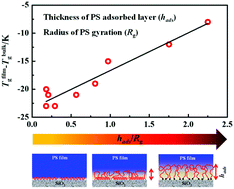The architecture of the adsorbed layer at the substrate interface determines the glass transition of supported ultrathin polystyrene films†
Abstract
To elucidate the mechanism underlying the effect of polymer/solid interfacial interactions on the dynamics of thin polymer films, the glass transition of thin end-functionalized polystyrene films supported on SiO2–Si, such as proton-terminated PS (PS-H), α,ω-dicarboxy-terminated PS (PS-COOH), and α,ω-dihydroxyl-terminated PS (PS-OH), was investigated. All the PS films exhibited a substantial depression in Tg with decreasing film thickness, while the extent of such depression was strongly dependent on the chemical structure of the end groups and molecular weights. It was found that Tfilmg − Tbulkg of the various PS films increased linearly with increasing hads/Rg, in which hads is the thickness of the interfacial adsorbed layer and Rg is the radius of gyration of PS. The hads/Rg is a direct reflection of the macromolecular chain conformation within the adsorbed layer which was affected by its end groups and molecular weights. These findings are in line with the work of Napolitano, and present direct experimental evidence.


 Please wait while we load your content...
Please wait while we load your content...